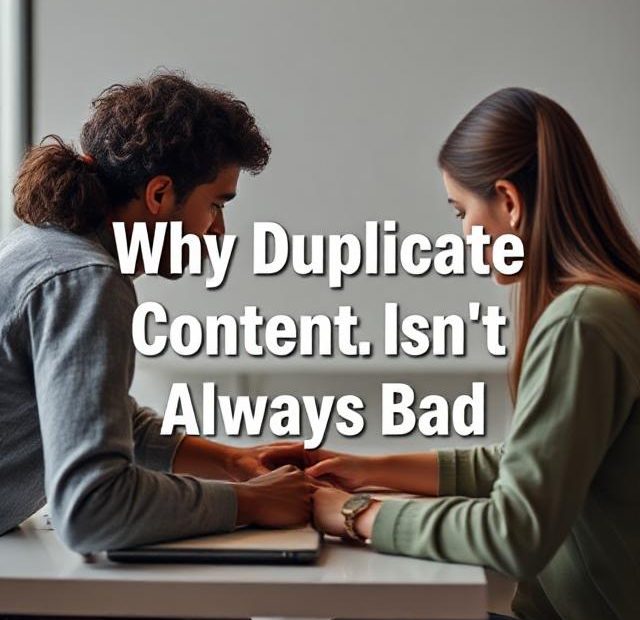If you’ve ever dabbled in search engine optimization (SEO), you’ve likely heard the warning: “Avoid duplicate content at all costs.” For years, this advice has echoed throughout blogs, SEO guides, and marketing courses. But in 2025, it’s time to set the record straight—duplicate content isn’t always bad.
Yes, search engines aim to deliver unique, relevant content to users. And yes, excessive duplication can harm your rankings. But that doesn’t mean every repeated paragraph or syndicated article triggers an SEO penalty. In reality, the truth about duplicate content is far more nuanced.
Let’s break down the myths, explore when duplicate content is acceptable, and help you understand how to handle it smartly.
What Is Duplicate Content?
Duplicate content refers to substantial blocks of text that are either completely identical or very similar to content found elsewhere—either on the same website or on a different domain.
This can happen in various ways:
-
Copied product descriptions across multiple product pages
-
Syndicated blog posts shared across different platforms
-
Printer-friendly versions of existing pages
-
Identical content served across country-specific domains
Contrary to popular belief, Google doesn’t automatically penalize a site for duplicate content. In most cases, search engines just try to figure out which version is most relevant for the searcher—and then rank that one.
Google’s Stance on Duplicate Content
According to Google, duplicate content is “not grounds for action unless it appears to be deceptive and is intended to manipulate search engine rankings or deceive users.”
In other words, intent matters. If you’re duplicating content to game the system—like copying a competitor’s blog post and pretending it’s your own—Google may penalize your site. But if the duplication is technical, accidental, or legitimate, there’s usually no penalty.
Instead, Google may:
-
Group similar pages together
-
Select a canonical version to show in search results
-
Filter out duplicates to provide a better user experience
When Duplicate Content Is Totally Fine (or Even Helpful)
Here are some perfectly acceptable situations where duplicate content doesn’t pose a threat:
✅ 1. Product Pages on E-commerce Sites
If you run an online store and sell similar items with only slight variations (e.g., color, size), your product descriptions may be very similar. This is a common, manageable case of duplication—especially if your content is accurate and user-focused.
✅ 2. Syndicated or Republished Articles
Let’s say you publish a blog on your website, and later, a respected platform republishes it (with credit). As long as there’s a canonical tag or clear attribution, this kind of duplication helps expand your reach without harming SEO.
✅ 3. Printer-Friendly or Mobile Versions
Some websites offer separate versions of pages for printing or mobile viewing. Google recognizes this as a technical necessity and won’t penalize it—as long as the content isn’t being manipulated.
✅ 4. Multiple Language Versions
If your site serves global users with the same content in different languages or regional variations (e.g., en-UK vs. en-US), that duplication is often necessary and expected.
When Duplicate Content Can Be a Problem
Though it’s not always harmful, duplicate content can become an issue in certain scenarios:
❌ 1. Copied Pages Without Attribution
If you’re taking someone else’s content word-for-word and presenting it as your own, Google will view this as plagiarism—and may penalize you accordingly.
❌ 2. Unmanaged Content Across Domains
If you manage multiple websites and copy/paste content between them without using canonical tags, search engines may get confused about which version to rank.
❌ 3. Thin or Boilerplate Content
Repeating low-quality or generic content across many pages—especially when it offers little to no value—can hurt your rankings. Examples include mass-produced location pages or doorway pages.
How to Handle Duplicate Content Smartly
To stay safe and SEO-friendly, here are a few practical strategies:
🔧 Use Canonical Tags
A canonical tag (<link rel="canonical" href="URL" />) tells search engines which version of a page is the “master” copy. It’s the best way to deal with duplicate content you intentionally publish (e.g., for syndication or versions of a product page).
🔧 Add Noindex Tags Where Needed
If you have duplicate or thin content that you don’t want indexed (like thank-you pages, internal search results, or print versions), use the noindex tag to keep them out of search engines.
🔧 Consolidate Similar Pages
Rather than having 10 pages that all say basically the same thing, consider merging them into a single, comprehensive post. This improves content depth and strengthens SEO performance.
🔧 Provide Unique Value
If you must include similar content across pages, add unique elements to each one—like reviews, case studies, FAQs, or updated examples—to offer extra value to users and search engines alike.
Final Thoughts
The myth that all duplicate content is bad needs to be put to rest.
In today’s SEO landscape, duplicate content is only harmful when it’s deceptive or mismanaged. Most of the time, it’s a technical issue, not a red flag. With proper tools like canonical tags, strategic planning, and content clarity, you can navigate it just fine.
Rather than fearing duplication, focus on intent, user value, and clarity for search engines. That’s how you stay ahead in modern SEO without falling into outdated traps.
Also, you can learn more about Meta Keywords here.
